20 December 2023 Post Number 592

Longtime readers will remember my enthusiasm first for the Squeezebox streaming audio DACs, then later, for the Google Chromecast-Audio disk/puck. In 2015, the Chromecast-Audio streamer was introduced for a mere $35, which included a 5Vdc power supply and 3.5mm stereo patch cord.
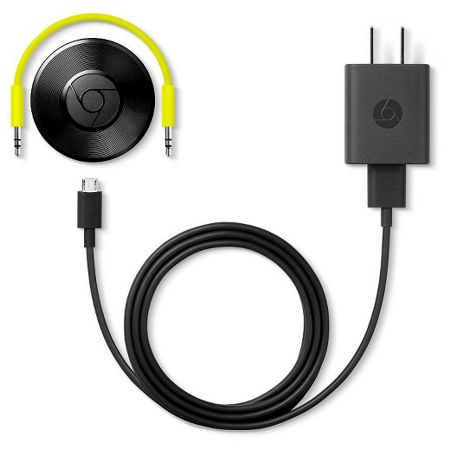
With this 2-inch disk and a Wi-Fi connection, you could stream music from either your phone or tablet or computer. The tiny puck (the word "puck" sidesteps the disk-disc controversy) received the Wi-Fi radio signal and an internal stereo DAC converted the digital code into analog output. In addition, we had the option of plugging in a 3.5mm fiber optic connector that allowed us to bypass the internal DAC and feed the digital stream to an External DAC. Because the Chromecast pucks were so cheap, you could fill your house with them, giving each its own name and controlling each through the Android app, Google Home. In fact, you could even stagger the millisecond timing between the pucks.
Of course, I was not content to limit myself to its intended use, so I envisaged gobs of new applications that would have horrified the Google engineering team, such as taking advantage of its wireless and ground-free features to use it in an electrostatic headphone amplifier, wherein the puck's floating power supply was referenced to -285Vdc! Safely encapsulated within its plastic case, the puck was even safe to touch, in spite of being situated hundreds of volts below ground potential.
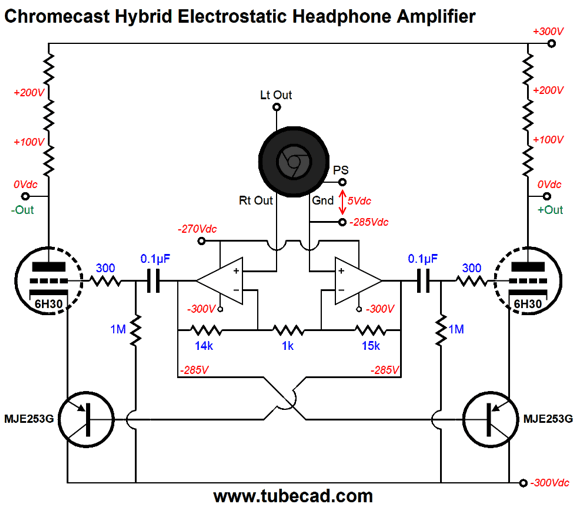
The floating 5Vdc power supply and no wired connection to the rest of your stereo allow safe operation of the puck. The cleverness of this circuit extends beyond the elimination of two internal coupling capacitors, but includes the sidestepping of the problem of negative power-supply-rail ripple. See post 384 for more out-there possible circuits.
The downsides to the Chromecast Audio puck were trivial to most, but irksome to audiophiles. For example, the DAC's audio and optical digital output topped out at a 96kHz sample rate at 24-bit resolution. Worse, it only got that high-res Wi-Fi signal from a computer or laptop, but not from phones or tablets; with these last two devices, the data streamed at a limited 44.1kHz sample rate at 16-bit resolution. Moreover, not all audio apps recognized the Chromecast puck as a viable audio output device. Less important, the pucks ran hot, as they drew 1A from the 5Vdc power supply. At the time, I wished that Google had offered a deluxe and larger version for around $99 that would sport a better DAC and more features, such as an app to consolidate and display your music collection on your main computer to be seen on a phone or tablet. It never happened.
What did happen is that another company filled that need— namely, WiiM, with its Mini.
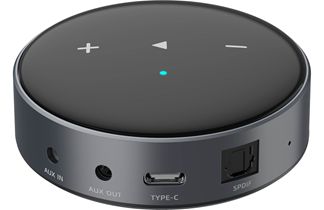
This hockey-puck sized streamer delivered most of what I wanted from Google; it even hit the $99 price tag. With its optical output, we can deliver the digital stream to our fancy DACs. Its own internal DAC accepts 24-bit/192kHz streams. It works with Apple Airplay2, and its phone app would make 99% of people happy. Sadly, the sound produced from its audio output was only marginally better than that from the old Chromecast Audio puck.
A few years ago, WiiM released their Pro Plus streamer DAC. It, too, is a streaming device that receives either WiFi or Bluetooth, and it, too, allows use of either its own internal DAC or the shooting of the raw digital out via an optical or RCA data jack. In other words, it is something like a fancy replacement for the Mini. Well, Black Friday came and my purchase was made.
What I love about the Pro Plus is that it can be controlled by either my phone or my tablet. In addition, it comes with a handy remote control. The Brit magazine, What HiFi, offers a good review of it.
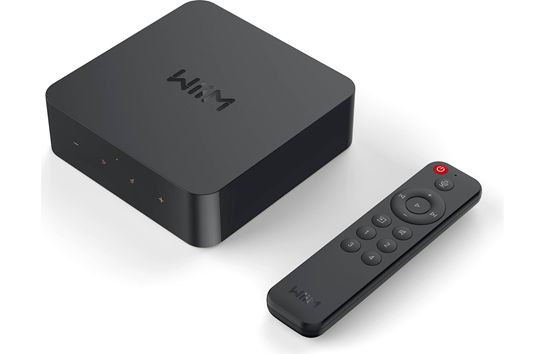
WiiM's in-house app runs on smart phone, tablet, or PC. Most will be delighted with the app, but the version for Windows, which is only in beta, cannot deal directly with my vast library of thousands of albums, as it seems to choke on its staggering immensity. Instead, I use the Android version of the app on my phone and tablet with my MediaMonkey music app located on my PC computer. In other words, MediaMonkey handles my music collection on my PC that stores all the music on an SSD 4T drive, while the WiiM app on either my phone or my tablet accesses the PC-based MediaMonkey app through Wi-Fi. Here is a screen capture of MediaMonkey on my PC.
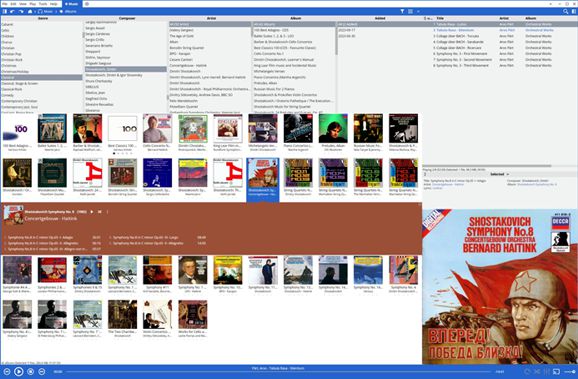
MediaMonkey offers too many features to list, but my favorites include its ability to convert file formats and to look up missing album information and its CD ripping, which compares your rip with those that others have performed. If nothing else, it makes a great tag editor, as it allows group alterations and auto increment of track numbers, which is a godsend when you have ripped the ten CDs of an audio book and want all 230 tracks numbered correctly. The WiiM Android app taps into the MediaMonkey database, which allows the WiiM app to display cover art and album details. Here is a screen shot from my Samsung tablet of the WiiM app.
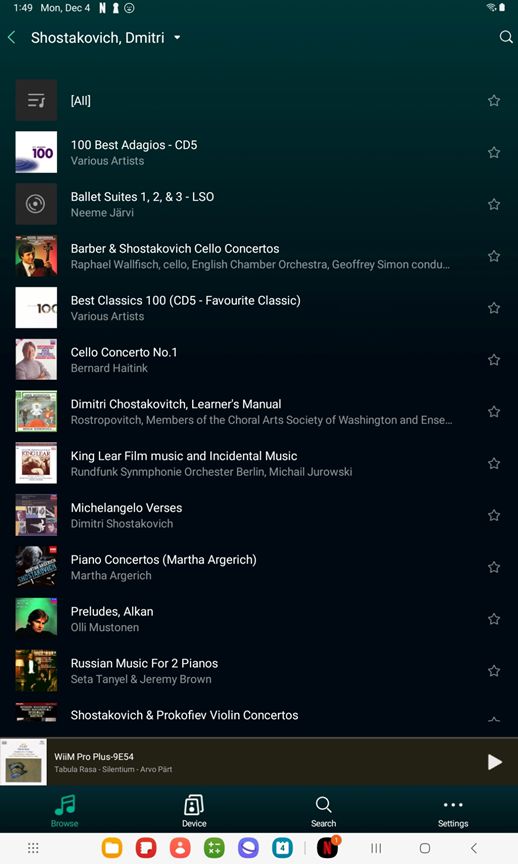
I gave the WiiM Pro Plus own internal DAC a serious listen. Not bad, certainly better than the Chromecast Audio puck, but not great. The Asahi Kasei Microdevices AKM4493SEQ 32-bit DAC chip appears in a few expensive DACs, but I do not believe that the WiiM fully exploits its potential. Why not? As it stands, the WiiM Pro Plus is a bargain at $229, as that is what many expensive DACs charge just for their remote control. Taking the Pro Plus 's sound up a notch would require a better and beefier power supply along with better and more expensive OpAmps and coupling capacitors—all of which could easily double or triple the price. (I can imagine some enterprising solder slinger opening up the WiiM Pro Plus and making the modifications himself.)
Mind you, 99% of the population will find no fault with the sound emerging from the WiiM Pro Plus; indeed, I can imagine some actually preferring its narrower and flatter soundstage, as they would find it more familiar sounding—much in the same way as some children find actual strawberries and cherries disappointing when compared to their gummy-bear equivalents. Since my goal was to find a streamer that came with a useable app, however, the WiiM Pro Plus's internal DAC was not my key concern.
Hooking it up via its digital RCA output jack to my Schiit Gungnir rev-B multibit DAC, which readily accepts the digital stream, the resulting sound is identical to running the Schiit DAC directly from an USB cable. I also hooked up my Pro-Ject Pre Box S2 DAC; in fact, I hooked up all three DACs to my dual-cathode-follower unity-gain line-stage buffer, which accepts up to three input signal sources. I used identical interconnects and held a sonic shootout.
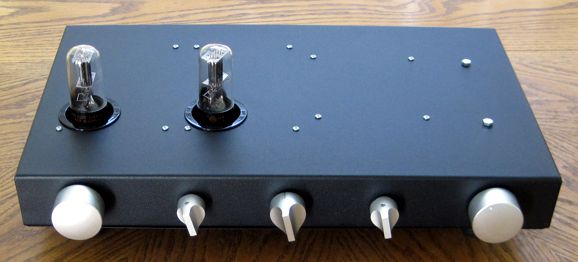
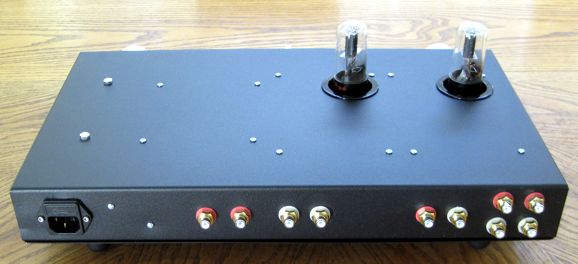
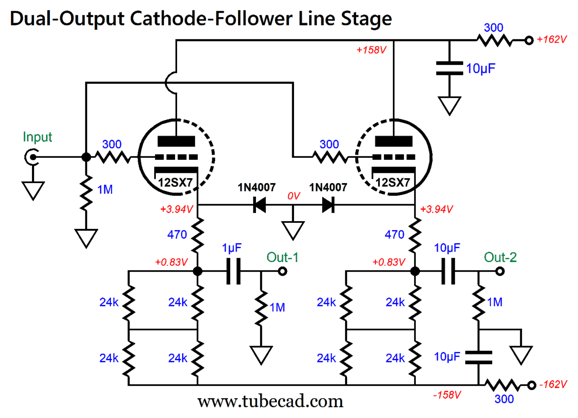
One interesting feature is that the WiiM Pro Plus also contains a stereo ADC (an analog-to-digital converter), the Burr-Brown PCM1861 ADC, which is capable of delivering up to 192kHz at 32-bit output. Mercy! The back of the unit shows several analog inputs: a stereo line in and microphone input.
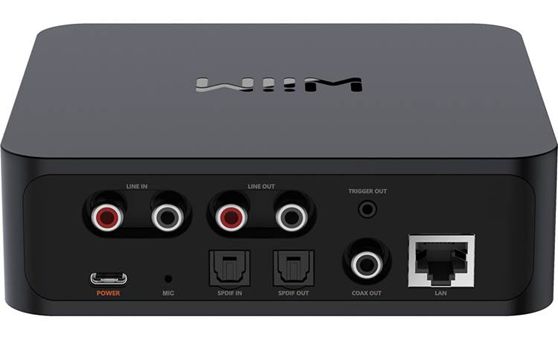
The Pro Plus also sports SPDIF and coax outputs. With the stereo line-in inputs, we can feed the signal output from a phono preamp and then capture the digital stream to record, or we can stream the digital signal to another streaming device.
In addition, the WiiM Pro Plus is now Roon-ready and certified. Moreover, it can control existing Chromecast Audio pucks. Okay, so it looks like what the audio world needs—it got already with the WiiM Pro Plus. So what else does the audio world need?
It needs all existing music-apps to add a new field to their internal database: sub-genre. A single database selector, "genre," is far too limiting. Here is an example: with my own music collection, the genre of World Music contains 69 sub-genres. Not only do we have African, but many sub-genres within that heading, for example Kenyan and Nigerian music. Moreover, there is Afro-Celt, Afro-Cuban, Afro-Latin, Afro-Portuguese… I can list 19 sub-genres for blues; too many sub-genres for classical music. Even rock can subdivide into many sub-genres, such as art-rock, British-Invasion-rock, folk-rock, hard-rock… Imagine if all dogs were classified only by the word "dog," with no breed names available. Of course, a dog is not a pet bird or cat or a horse, but further specification is welcome. Thus, we get a cascade of classification: pet, dog, hound, beagle, male, Toby.

I just assembled the new version of the Aikido 12Vac. This four-tube line-stage amplifier is powered by a wee 12Vac, which can be sourced from either an internal power transformer of an external wall-wart transformer. DC switching power supplies are not allowed! I made a few improvements on the old design, such as greater B+ voltage and ability to use either 6.3V tubes, such as the 6DJ8, or 12.6V tubes, such as the 12AU7. In addition, I added to the PCB an optional resistor, R12, which allows us to burn off excess signal gain. Why would anyone want to do that?
Rare are modern signal sources that don't deliver at least 1Vpk of output signal. In days past, tuners and tape players often delivered only 0.5Vpk of signal. Today, most CD players and standalone DACs put out over 2Vpk. Most power amplifiers can be brought to full power output with 2Vpk of input signal. In other words, not that much gain is needed from a line-stage amplifier. I find that 12dB of gain (i.e. 1V to 4V) works well.
A 6DJ8-based Aikido will deliver 24dB of gain. To reduce that gain to 12dB requires an attenuation of -12dB, this translates into a quartering of the signal. The math is simple: take -12dB and divide by 20, which yields -0.6; now take 10 to the –0.6 power and get 0.25 as the result. A pair of 150k and 50k attenuator resistors will do it in a two-resistor voltage divider.
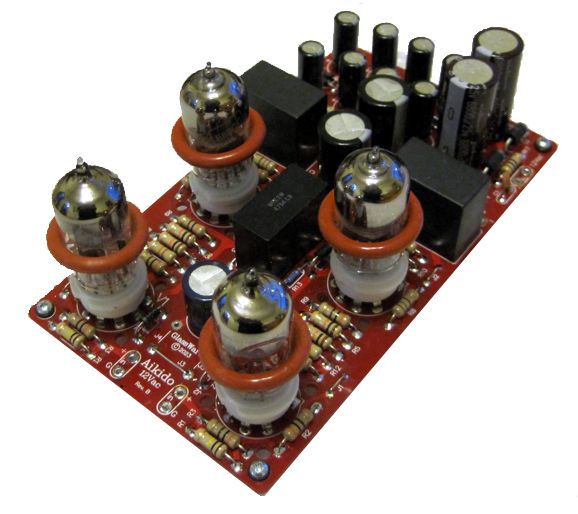
Here is one channel on the new Aikido 12Vac Rev. B PCB.
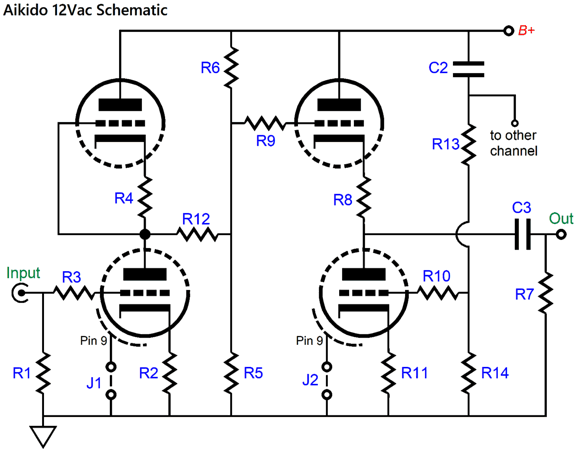
Normally, resistor R12 would be replaced with a jumper wire, while resistors R5 & R6 would be 1M in value. These two resistors just help center the DC entering the Aikido-cathode-follower output stage; in addition, they allow discharging of the B+ voltage when the unit is shut down and give the ACF output stage a DC reference voltage if the input tube is missing from its socket. Well, we can use 100k resistors in place of the 1m resistors, and we can use a 150k resistor for R12. The two 100k resistors are effectively in parallel, so their combined resistance is 50k. This 50k resistance in series with the 150k resistor creates a two-resistor voltage divider, whose attenuation is -12dB.
Wait a minute, John; you have burned off 12dB of signal gain, but you have also increased the distortion, as the input stage must swing 4Vpk to get 1Vpk of signal output. The bigger the voltage swings, the greater the distortion.
True. The question that must be asked: Is the distortion produced by a triode-based single-ended amplifier a bad thing or a good thing? Of course, too much of any good thing becomes a bad thing. Calcium, iron, vitamin A, and vitamin D are essential to human life, but excessive intake will lead to overdose symptoms and, ultimately, death. As Mr. Wilde so wisely put it, "Everything in moderation, including moderation." The one exception is thought.
From post 15:
I like to think in extremes—no matter what the subject is. Extremes reveal what small increments hide. For example, which is better: no federal income tax or 100% federal income tax? Which yields higher federal revenues? (If you answered 100%, would you really work if you didn’t get to keep any of your money?) In a tube power amplifier, which is better: high voltage and low current or low voltage and high current, given an optimal transformer in both cases? Actually, it's best if you drop the evaluative ("better") judgment and just ask what happens at one extreme versus its opposite. Still, I can see why Socrates was killed; few like to play this game. Yet I cannot think of any better advice to the electronic novice than to develop the habit of extreme thinking.
Moreover, Eric Hoffer rightly pointed out that all thought requires exaggeration and that an unwillingness to exaggerate often betrays an unwillingness to think. Well, as an experiment, I decided to go extreme, as I reduced the signal gain to unity-gain, i.e. 0dB. One-volt peak in and one-volt peak out. No gain, but all the distortion (i.e. harmonic enhancement).
I used 10k resistors for R5 & R6 and a 56k resistor for R12, and the gain went from 24dB to 0dB. Here are the rest of the part values that I used.
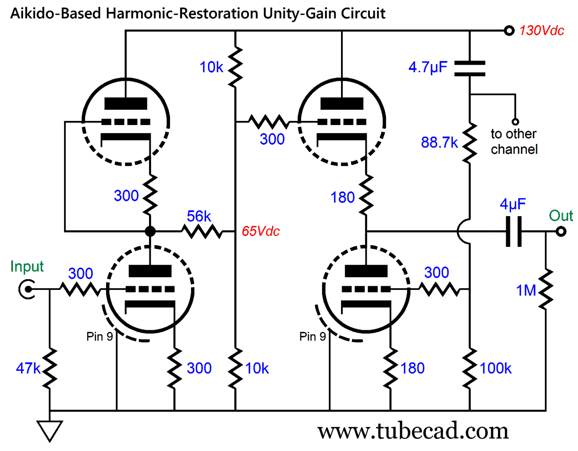
Both the tubes are 6DJ8 types. The PCB holds both a high-voltage power supply, with double RC filtration, and low-voltage power supply for the heater filaments, with zener voltage regulation.
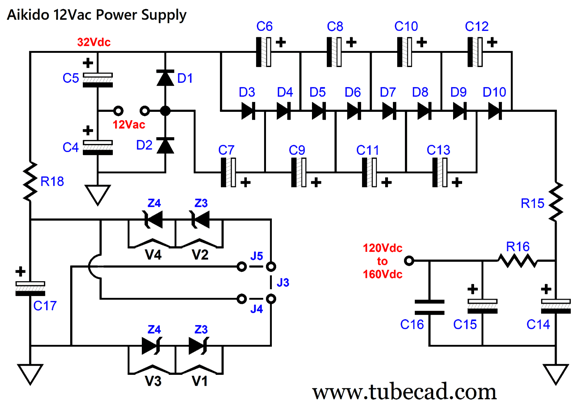
The string of diodes and eight capacitors increase the 12Vac to 160Vdc. This voltage-multiplier circuit is a half-wave rectifier affair, which the two RC filters in cascade smooths out.
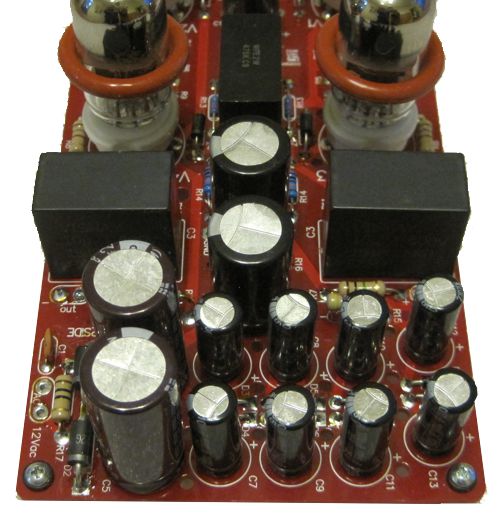
The previous Rev. A version of the Aikido 12Vac held a less ambitious power supply, which delivered a B+ voltage of around 90Vdc.
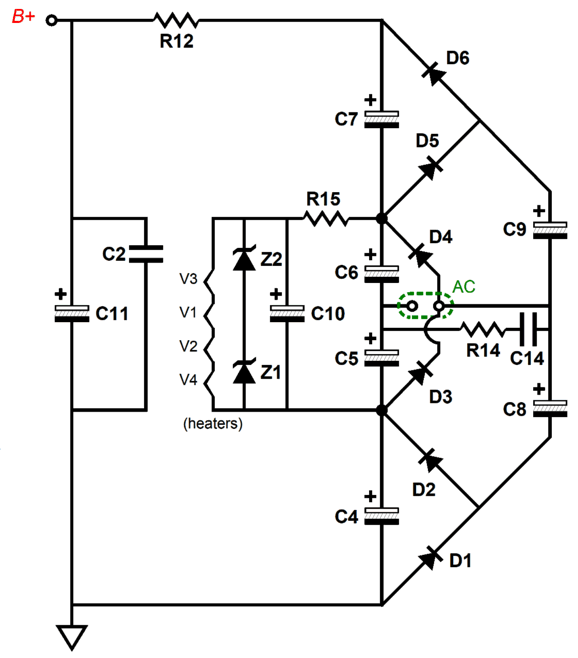
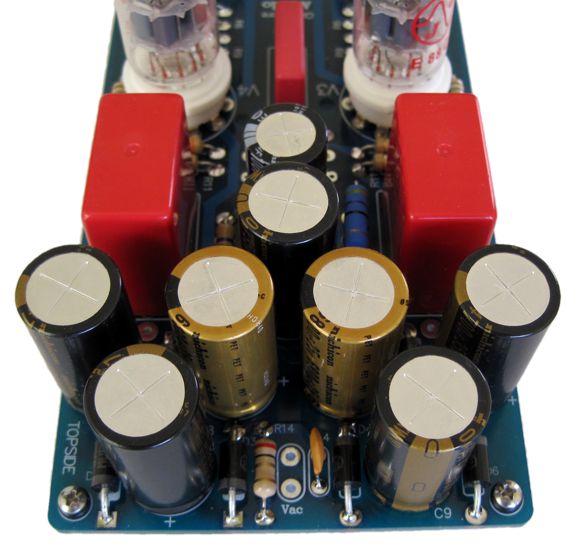
The new Rev. B PCB is a tad wider, 4in compared to 3.6in, than the old version.
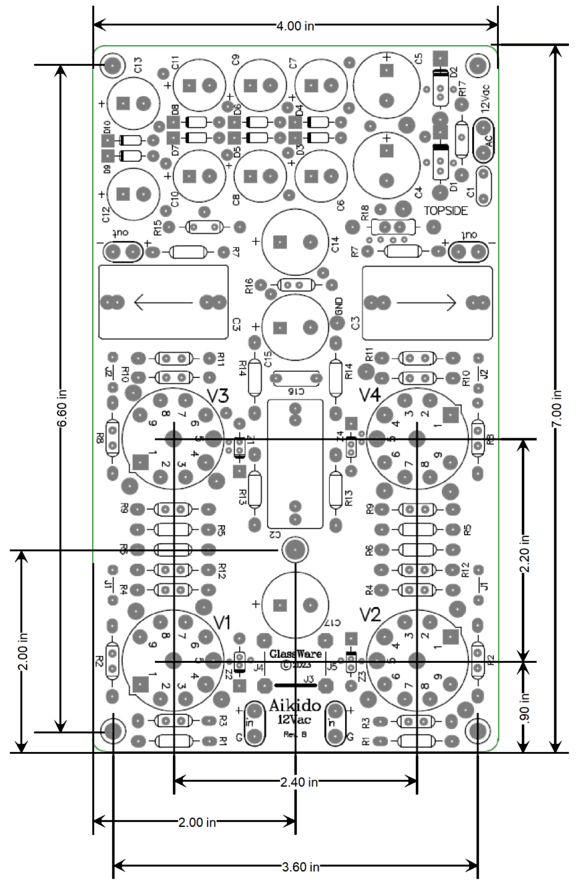
In order to test quickly the design, I highjacked an existing project's enclosure. The small-extruded box had held an ACF 12Vac PCB.
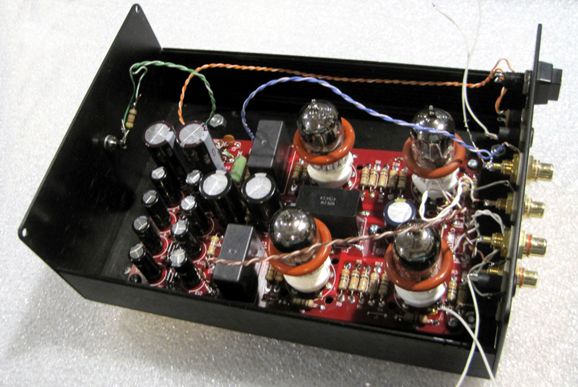
The four dangling white wires are not attached to the PCB, as they are there for polarizing the interconnect cables; I wanted to hear just the circuit, not the cables.
How does it sound? In spite of using a woefully underpowered 12Vac wall-wart transformer (only 24VA, where 36VA is needed) and the wrong output coupling capacitors, it sounded quite good. Not anything approaching overly ripe, but warmer and less mechanical sounding than the direct signal output from the DAC. A tad tube-esque, but not egregiously so. (A few months ago, I brought over the ACF circuit in this enclosure to a friend's house. He had just bought a DAC that cost well over $5,000. We placed the ACF in between the DAC and his line stage. Instantly, better tonality and imaging.)
At last, I found my desired and misplaced coupling capacitors and gave the unity-gain Aikido another listen. Okay, much better. Everything improved from the low-bass to imaging. Bear in mind that I am running tube-based single-ended power amplifiers, so I didn't need much more tube-sound overlay, just enough to mellow the DAC's slightly mechanical-brittle sound. With a transistor-based power amplifier, no doubt, more tube glow would be needed.
The problem, which is an odd problem, is that audio triodes are so dang linear that forcing them to deliver high distortion is difficult. What to do?
I could further drag down the Aikido by using even lower-valued shunting resistors, but this would also drag down the power supply, as the resistors would draw more current. An interesting possibility would be to use an input signal transformer with a step-up ratio of two or four, then use a larger resistor value for resistor R12 to bring the final gain back to unity.
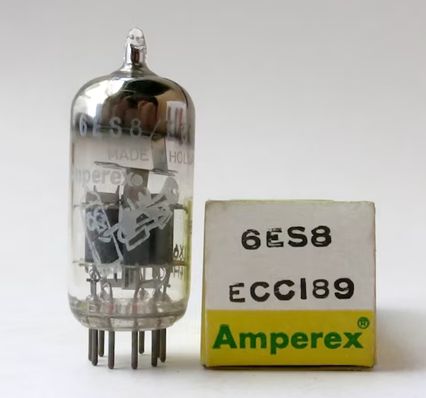
One possible and far easier workaround would be to replace the input 6DJ8 with a 6ES8/ECC189 twin-triode. This tube looks like a 6DJ8 and shares the same pinout, but differs in that it is a remote-cut-off triode. Its grid assembly was specially designed to follow a varying spacing between turns, which creates a variable-mu triode. In fact, the tube manual data does not bother to specify its amplification factor (mu), as it varies across its plate curves. Nonetheless, like the 6DJ8, it is low-noise design and offers high transconductance. It should, however, generate some serious 2nd harmonic distortion. My goal is 1%, but 5% would be fun to try. (5% was the old-time limit for single-ended and push-pull tube-based power amplifiers.)
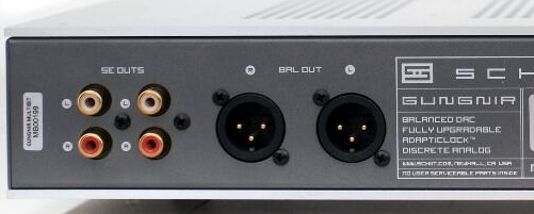
Much of this year's posts have had the topic of how to exploit the XLR balanced outputs on my DAC. My power amplifiers are not balanced, and they only accept unbalanced RCA jack input signals. As I put together my Aikido-based harmonic-restoration circuit, the brain flash of a potential new arrangement hit me: I could build a variable harmonic-restoration circuit that used a linear potentiometer and allowed an adjustable amount of harmonic restoration, from none to lots. The secret relied on the two-phase balanced outputs from the XLR jacks. The Aikido amplifier stage inverts its input signal at its output. If fed an already inverted input signal, the Aikido's output signal would be non-inverting. If we bridge the Aikido's output to the XLR's non-inverting output with a potentiometer, the potentiometer's scraper delivers the blend of the two non-inverting signals, one warm and rich, the other cool and thin.
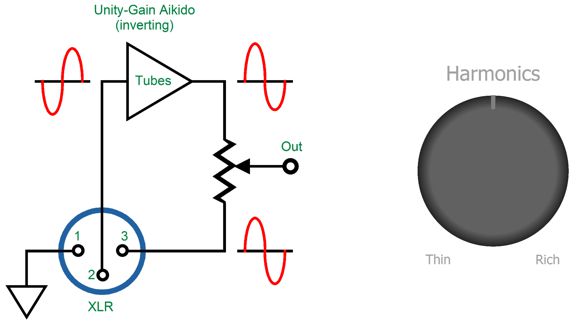
Imagine that you are listening to a classical recording from the early 1970s, when transistors took over in the recording studios. The sound irks in the extreme, sounding edgy and gritty. You turn the knob to the right. In contrast, an overly ripe recording from the 1950s would benefit from some solid-state sonic desiccation.
If we desire balanced outputs, we need to double up on the Aikido stages.
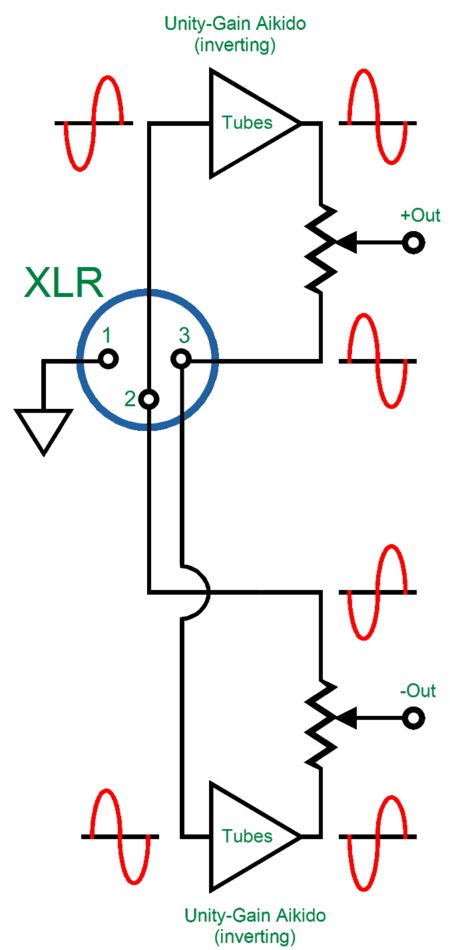
Four-ganged linear potentiometers are needed for stereo use. In addition, we can add a phase-selector three-position rotary switch, with mute in the center position. If we are going to exploit the balanced output, we might as well exploit hard.
One thought I had was that we could use fewer tubes. For example, we could modify a constant-current-draw amplifier stage (CCDA), which requires only one twin-triode tube per channel. This circuit delivers gain and low output impedance with little hassle. In addition, it unloads the B+ voltage power supply in AC terms, as it draws a fairly constant current.
.png)
This inverting gain stage will deliver gain; with the 6DJ8, we can expect 24dB worth (i.e. 1:16). Replacing the 6DJ8 with a 6SN7 will drop the gain to about 20dB (i.e. 1:10).

The same trick that was used in my unity-gain Aikido is employed here, as the 150k resistor and the four 20k-resistors reduce the gain down to 0dB (i.e. unity gain). The 360-ohm resistor was added to balance the output impedance from the 6SN7-based cathode follower. Another possible arrangement is to terminate the two-resistor voltage divider with a capacitor.
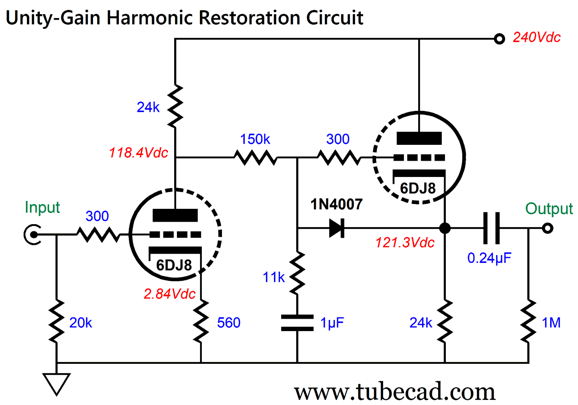
The capacitor values were not arbitrarily chosen, as the 150k and 11k resistors not only define a two-resistor voltage divider but also a low-frequency shelving network. In other words, DC and low frequencies pass freely, but higher frequencies are attenuated. The 0.24µF output coupling capacitor imposes a high-pass filter that undoes the shelving function.
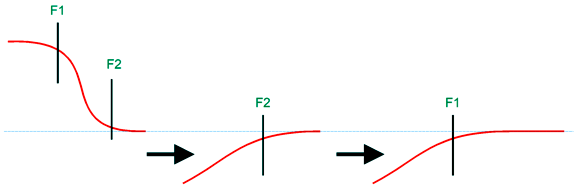
The problem we face with this workaround is that the external load impedance imposed by the power amplifier input resistance, which can vary from 1k to 1M, will throw off our math. In other words, a possible 20k load resistance will shunt the 1M resistor and result in an actual load resistance of 19.6k. This will move the -3dB cut-off frequency up from 0.67Hz to 34Hz. This liability makes the previous circuit look far more appealing.
Another thought I had was: why can't we halve the number of triodes again?
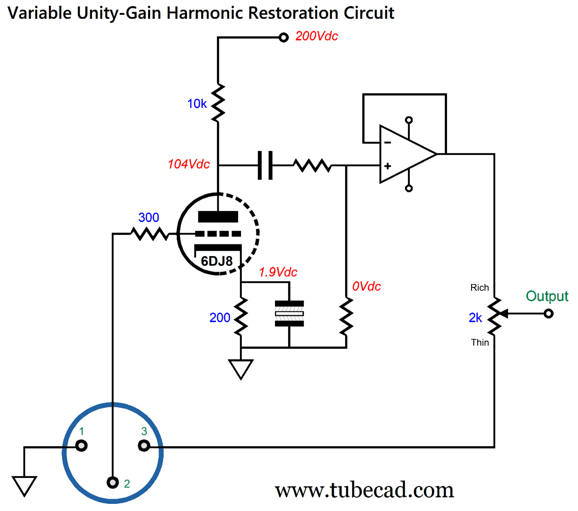
Note the bypassed cathode resistor, using a non-polarized electrolytic capacitor, which will help add 2nd-harmonic distortion, as unbypassed cathode resistors linearize triodes at the cost of less gain. With a bypassed Rk, the grounded-cathode amplifier yields higher gain, better PSRR, and lower output impedance, but at the cost of increased distortion. The OpAmp replaces a cathode follower and offers an equally low output impedance to the XLR outputs.
Of course, I instinctively scan all audio circuits for possible Aikido mojo enhancement. The 6DJ8 triode's plate resistance (rp) is in series with the 10k plate resistor, so the two effectively define a two-resistor voltage divider to the B+ voltage ripple. In other words, we can expect about a fourth of the ripple to leak out at the 6DJ8's plate, which will be further attenuated by the actual two-resistor voltage divider that feeds the OpAmp. Now it's time to get sneaky.
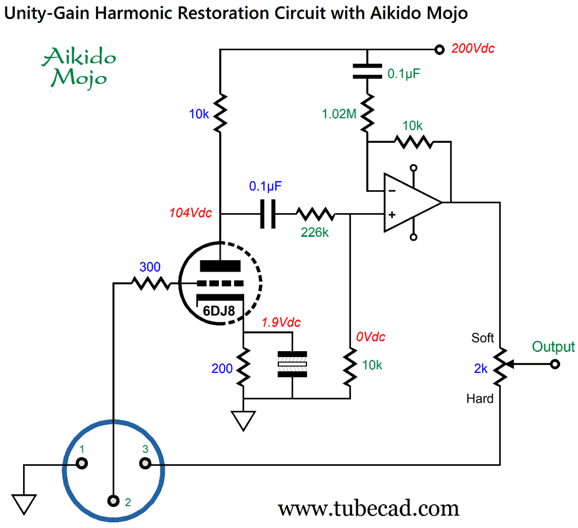
The OpAmp no longer offers unity-gain output, as its gain is now 0.085dB. Yep, not much more than unity gain's 0dB. What has changed dramatically is the PSRR. Here is the SPICE-generated graph that shows the improvement.
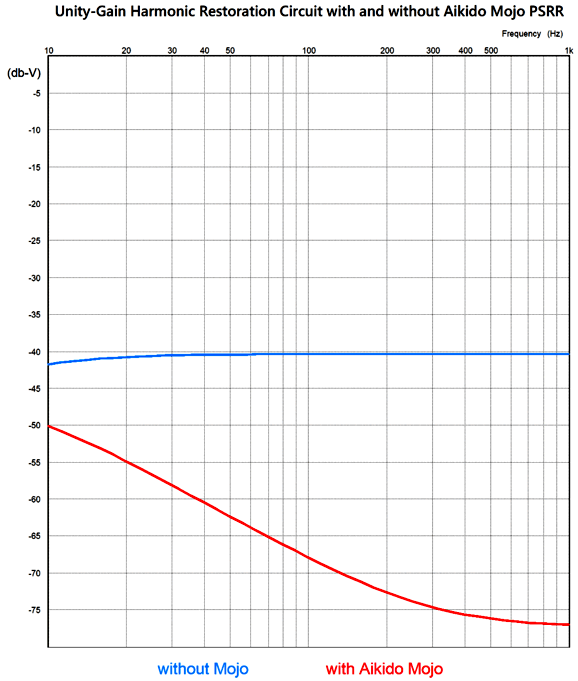
By the way, we can create a hybrid amplifier with Aikido-mojo based on this same technique.
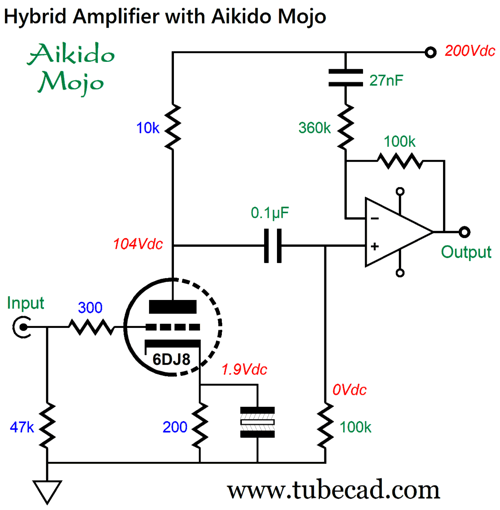
The gain realized by the triode alone is about 27dB, but the OpAmp brings it up to 29.5dB. More importantly, the OpAmp delivers a low output impedance and greatly improves the PSRR.
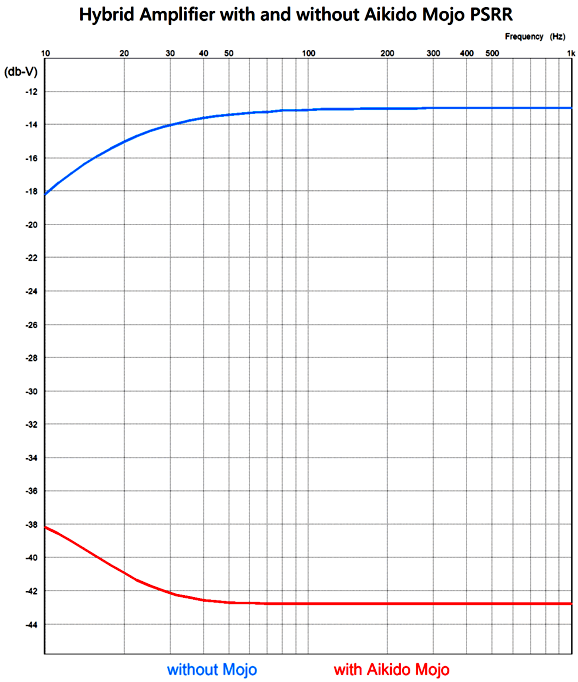
At 100Hz, we are looking at about a 30dB improvement in PSRR. No doubt that with some fine tweaking of values, even better PSRR could be had. Add a high-voltage regulator, and a decent hybrid phono preamp might be built. Imagine two of these hybrid gain stage separated by a passive RIAA equalization network.
If the cathode resistor is unbypassed, the math demands different part values.
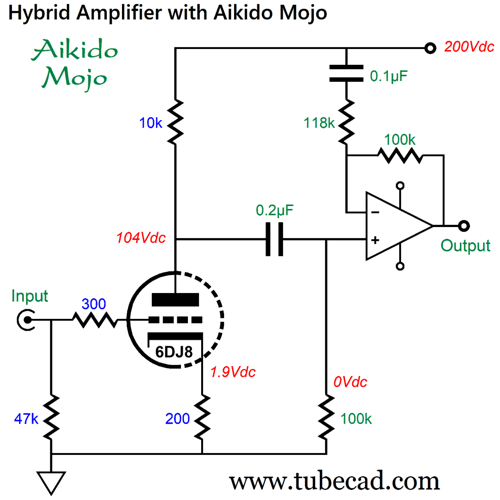
Interestingly enough, the gain remains at 29dB. (The OpAmp delivers a gain of 6.8dB in this configuration.) The PSRR improve to -47dB at 100Hz. The DC offset voltage should be low at the OpAmp's output, as its input resistor matches its negative feedback loop resistor in value.
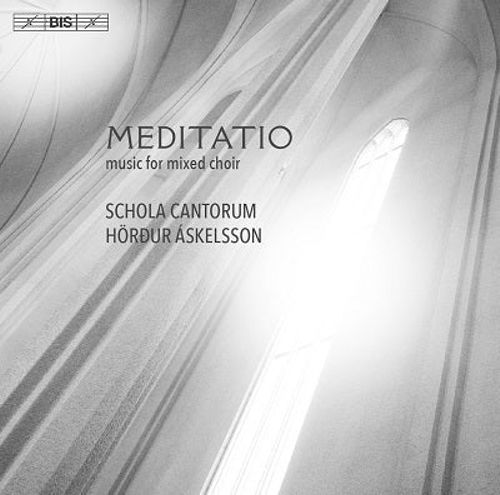
It's winter and week before Christmas, but I haven't found any new Christmas music worth pointing out. I did discover, however, two albums from the BIS classical label that can pass for Christmas music, Meditatio and Meditatio II. I had never heard of the Schola Cantorum before, but I knew if they were recorded by BIS, they are worth a listen. I was right, as the music and recording are excellent. Here is the back cover for the first album:
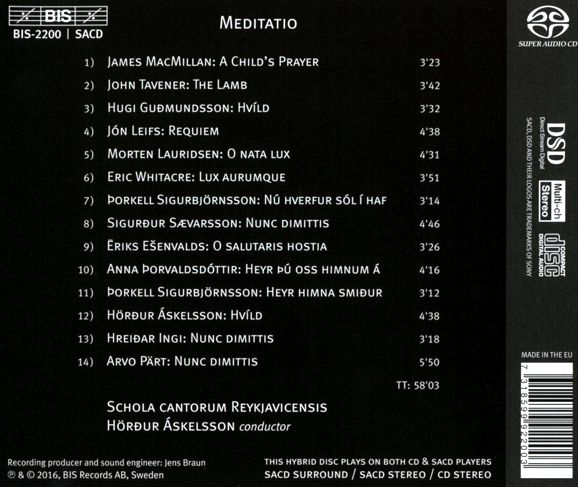
I had only heard of five of the composers listed, which was enough to warrant my listening to the entire album. The second album, recorded in 2023, Meditatio II, continues with a similar array of songs. Both albums offer some lovely music. By the way, the vast bulk of the compositions are relatively new—many, if not most were composed after I was born. In other words, do not shy away from giving these two albums a listen due a fear of looming monotony; impending repetitiousness and wearisomeness are not part of the mix.
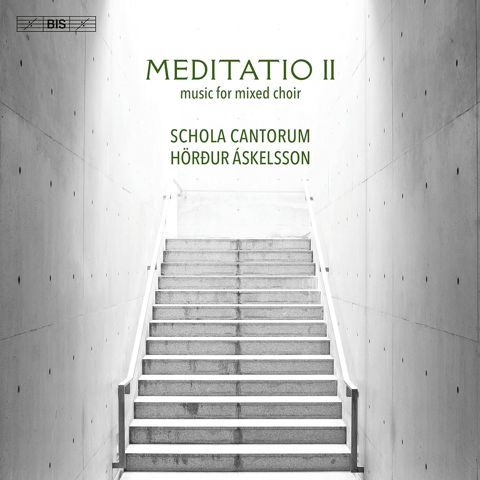
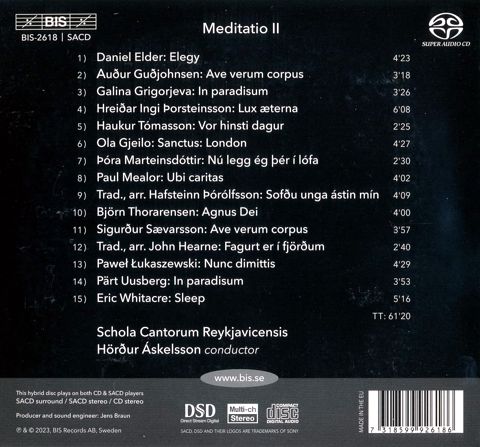
Amazon Music offers its streaming in 24-bit, 96kHz.
//JRB
Did you enjoy my post? Do you want to see me make it to post 1,000? If so, think about supporting me at Patreon.

  
Just click on any of the above images to download a PDF of the user guides.

For those of you who still have old computers running Windows XP (32-bit) or any other Windows 32-bit OS, I have setup the download availability of my old old standards: Tube CAD, SE Amp CAD, and Audio Gadgets. The downloads are at the GlassWare-Yahoo store and the price is only $9.95 for each program.
http://glass-ware.stores.yahoo.net/adsoffromgla.html
So many have asked that I had to do it.
WARNING: THESE THREE PROGRAMS WILL NOT RUN UNDER VISTA 64-Bit or WINDOWS 7, 8, and 10 if the OS is not 32-bit or if it is a 64-bit OS.
I do plan on remaking all of these programs into 64-bit versions, but it will be a huge ordeal, as programming requires vast chunks of noise-free time, something very rare with children running about. Ideally, I would love to come out with versions that run on iPads and Android-OS tablets.
|
|
|
|
I know that some readers wish to avoid Patreon, so here is a PayPal button instead. Thanks.
John Broskie

John Gives
To all my patrons, all 85 of them, thank you all again. I want to especially thank
Concordio Anacleto
Walter Clay
King Heiple
Kuldeep
Amy D. McNeil
Paul Radovan
Christian Rintelen
Jason Stoddard
Kelvin Tyler
Dwight Warren
I am truly stunned and appreciative of their support. In addition I want to thank the following patrons:
John Atwood
Hal Clark
Dean Bailey
Jim Burnes
Eduardo Fayad
Scott Fraser
Manny Gagliano
Mike Galusha
Richard Hansen
Andreas Hierzenberger
Erik Hoel
Dean Kayser
Tom Kelly
Thomas Kifowit
Francis King
Frank Klapperich
Neil Kovacs
Przemek Lach
Robert
Ron Lee
偉良 林 (David Lin)
Amy D. McNeil
Csaba Molnar
Joe Mooney
John R. Murray
Seiichiro Nakakura
Larry Owens
John Puma
Paul Reid
Marty Reiss
Paulo Mario dos Santos Dias de Moraes
Blake Swaney
Michael Taylor
Brian Terrell
James Tiemann
Dwight Warren
Andrew White
Sergey Yegourno
All of your support makes a big difference. I would love to arrive at the point where creating my posts was my top priority of the day, not something that I have to steal time from other obligations to do. The more support I get, the higher up these posts move up in deserving attention.

If you have been reading my posts, you know that my lifetime goal is reaching post number one thousand. I have 409 more to go.
My second goal was to gather 1,000 patrons. Well, that no longer seems possible to me, so I will shoot for a mighty 100 instead. Thus, I have just 15 patrons to go.
Help me get there. Thanks.
Only $9.95
to start designing
tube-based crossovers
and much more...
TCJ Filter Design


The Tube CAD Journal's first companion program, TCJ Filter Design lets you design a filter or crossover (passive, OpAmp or tube) without having to check out thick textbooks from the library and without having to breakout the scientific calculator. This program's goal is to provide a quick and easy display not only of the frequency response, but also of the resistor and capacitor values for a passive and active filters and crossovers.
TCJ Filter Design is easy to use, but not lightweight, holding over 60 different filter topologies and up to four filter alignments:
Bessel,
Butterworth,
Gaussian,
Linkwitz-Riley.
While the program's main concern is active filters, solid-state and tube, it also does passive filters. In fact, it can be used to calculate passive crossovers for use with speakers by entering 8 ohms as the terminating resistance. Click on the image below to see the full screen capture.


Tube crossovers are a major part of this program; both buffered and un-buffered tube based filters along with mono-polar and bipolar power supply topologies are covered. Available on a CD-ROM and a downloadable version (4 Megabytes).
|

























.png)






















